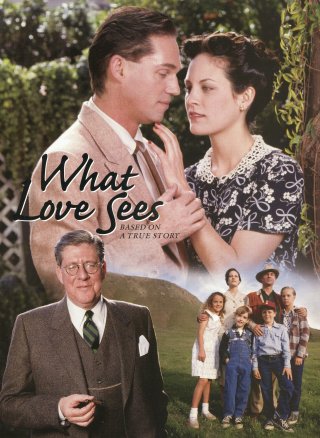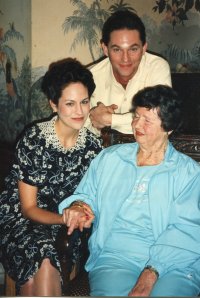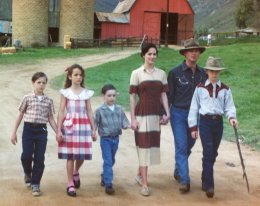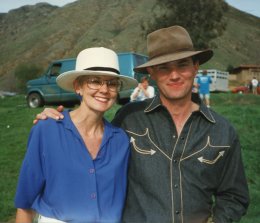The Story behind the StoryHow this novel came to be is best told in an article printed in The San Diego Union-Tribune, September 22, 1996. It explains as well how I came to be a writer of books, for What Love Sees was my first published book.
"A Deeper Vision:
|
|
|
|
"I got that from the Hollys," she said. Jean and Forrest Holly are the main characters in Vreeland's book, What Love Sees, the fact-based tale of a blind couple and the life they made for themselves on a ranch in Ramona. If the Hollys had held themselves back, they never would have been married. She was from a wealthy, over-protective family in New England. He was from a simple ranching family in San Diego County. They met through the mail, through letters that had to be read to them by other people. They lived in a small, drafty wooden house until he learned how to make adobe bricks and built them a bigger home. They raised four children. Blindness was a fact of life, not a way of life. "One of the things I felt strongly about in doing this story is that many of our limitations are self-imposed or socially imposed," Vreeland said. "Through the Hollys I saw that vision is not just a physical activity. They had a spiritual sense of vision, a deeper sense of vision. They would see things in people and situations that maybe a sighted person would miss." The first time Susan Vreeland saw Jean and Forrest Holly, they were at a large gathering, and people seemed drawn to the blind couple. "They got along so well there, and everybody seemed to love them," she said. This was in the early 1980's. Vreeland wound up talking to one of the couple's children, Faith. She heard the story about how Forrest had lost his sight in a football accident, about how Jean had lost hers to natural causes. She heard about how they had met through one of Jean's friends, traded letters and then trekked across the country to convince themselves (and their families) that they ought to get married. Vreeland learned, too, about the life the Hollys cobbled together beginning in the 1940s--how Forrest moved from cattle rancher to adobe-brick maker to building contractor through sheer force of will... "Gee, you really have a story here," Vreeland told Faith Holly. "You ought to write it." "You're the writer," Faith replied. "You write it." Vreeland had authored numerous newspaper and magazine articles, in addition to teaching English literature, art [ceramics], and creative writing in the San Diego Unified School District...but she had never tried a book. She thought about the project for several months, and the story wouldn't leave her alone. "It was just so interesting," she said. "They had a remarkable ability to live independently, not to feel they were living any less fully that the sighted world." Still, a whole book? "I don't think I can write a whole book," Vreeland remembers telling Faith. And Faith asked, "Well, do you think you can write a chapter?" That broke the logjam. "It helped me past the feeling of being overwhelmed by it all," Vreeland said. The book took about four years to write. Vreeland calls it a "biographical novel," because although it closely parallels the real story, some dialogue and scenes are invented to bring to life certain generalizations and character traits. To check the accuracy, Vreeland read chapters to Jean Holly, now in her '70's. (Forrest had died while the book was being written.) Sometimes, in the reliving of it, Jean would cry. Vreeland knew she had captured the family pretty well. "But I never expected my words to see the light of day," she said. Wrong again. The book was published by PaperJacks in 1988. It sold about 16,000 copies in two months. Then the publisher went out of business. So much for the big time. Vreeland went back to her teaching and writing. All of the Hollys settled in other places, in Oregon, Iowa, and Illinois, save for Will Holly, the second-youngest, who wound up in Carlsbad, California and worked as a photographer and airplane mechanic. And that, it seemed, was that. Until Vreeland one day got a phone call. Turns out that What Love Sees made its way to someone at Rosemont Productions, a company that makes TV movies, and then to Richard Thomas, the actor forever known as John Boy Walton. They liked the book and wanted to make it into a film. Thomas was eager to portray Forrest Holly.
Vreeland said crew members talked frequently about how nice it was to do a movie that didn't involve car crashes and gun play. "They all felt uplifted by this story," she said. One of her greatest joys was watching the interaction of the Hollys and the actors playing them... "There were a lot of hugs and mutual admiration--admiration from the family for the way the movie was retaining the integrity of the story, and admiration from the actors for the lives lived that had given them these characters to play."... "I guess I've learned a little of the Hollys refusal to accept limitation," Vreeland said.
|
|
|
|
|
|

|
|
|
|



